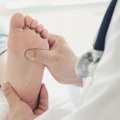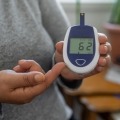Get in the Zone: My Tips For Avoiding Hypoglycemia During Exercise
By Adam Brown
.png) Diagnosing and solving hypoglycemia (lows) and hyperglycemia (highs) during exercise with diabetes. It’s all about personal experimentation.
Diagnosing and solving hypoglycemia (lows) and hyperglycemia (highs) during exercise with diabetes. It’s all about personal experimentation.
Exercise has been one of four complete gamechangers for managing my type 1 diabetes, but it can frequently be a source of confusion, frustration, exhaustion, and blood sugar unpredictability. I think this is partially why I get so many reader questions on this topic – managing blood sugars during exercise is challenging. Fortunately, it’s not impossible! This article shares what I’ve learned from athletes, healthcare providers, and 14 years of experimenting with blood sugars during exercise.
I strongly believe that anyone with diabetes can master exercise, and it all starts with becoming a good driver – maintaining the right speed (100-180 mg/dl) while applying the proper amount of gas and brake (food and insulin) at the right times. The big challenge is that universal driving recommendations aren’t possible, since everyone’s car model (i.e., body), car engine (i.e., diabetes, physiology), and road conditions (type of exercise) are different. The key is not to give up, as it can take a while to climb the learning curve and figure out what works for you.
This article offers a toolkit to help you on that path. Part I shares a diagnostic checklist, followed by some potential tactics to avoid lows and highs (Part II). Part III shares what I specifically do, in case it’s useful. I’m a pretty active person (much of my exercise is vigorous) and have figured out what works for me over time, so your adjustments could (and probably will) differ dramatically. You should absolutely talk to your healthcare provider before making any changes to your medications or routine. If you find this article useful, check out my upcoming book, Bright Spots & Landmines!
-
Part I: Diagnostic Checklist – What’s Working and What Needs Help?
-
Part II: Tactics to Avoid Lows and Highs During and After Exercise
-
Part III: My Driving Handbook: Exactly What I Do for Different Types of Exercise
[Editor's Note: Adam is a patient with diabetes and not a healthcare provider. This piece has been reviewed by the diaTribe Advisory Board for clinical accuracy. Please consult with your healthcare provider before making any changes to your diet, insulin, or medication regimen.]
Part I: Diagnostic Checklist – What’s Working and What Needs Help?
1. Do pre-, during-, and post-exercise blood sugar checks to understand how activity is affecting you. Most importantly, you want to know if your blood sugar is going low or high and when that is occurring. The goal is to stay in the zone of 100-180 mg/dl during exercise. Ideally, you can do tests when your blood sugar is high to start, so you can see the pure effect of activity without food or insulin changes obscuring it. A word of caution: many people experience delayed overnight lows following exercise, so you may need to add some occasional nighttime tests.
-
Continuous Glucose Monitoring (CGM) is a spectacular tool to safely exercise with diabetes (Dexcom, Medtronic). In addition to a new glucose value every five minutes, you get a real-time trend arrow and alarms, which allow you to make small changes on the fly (more below). As CGM data continues to move onto the phone and smartwatches, it’s going to be an even more useful tool during exercise.
2. What are you eating and how are you changing your insulin before, during, and after exercise? This establishes a baseline of what you’re currently doing, which will serve as a starting point for making tweaks.
-
Some people find a diabetes/exercise diary helpful. Write down what you ate, insulin changes, the activity type/length, and the timing of each. Apps like mySugr or Evernote can help you log this, or you can use pen and paper.
3. Where are your “bright spots” – when things go well and you start and end in target range, what did you do with your food, insulin, and the timing of each? Can you replicate the choices you made next time?
Once you have a sense of what you’re currently doing, you can try tweaking two major variables. Some potential changes are listed below in Part II. This is where the personal experimentation starts!
-
Food (primarily carbs) – Like a gas pedal increases speed, food increases blood sugar. You can tweak the amount of food, the type of food, and the timing of food.
-
Insulin – Like a brake pedal reduces speed, insulin reduces blood sugar. You can adjust the amount and timing of insulin (both bolus and basal).
Part II: Tactics to Avoid Lows and Highs During and After Exercise
I’ve included a toolbox of tactics below that can help avoid low and high blood sugars during exercise. You will need to experiment to figure out what combination of things works for your particular circumstances. These are simply suggestions, and you should make sure to confirm any changes to insulin with a healthcare provider.
A. “I KEEP GOING LOW DURING EXERCISE.”
|
Potential Tactics |
Notes |
|
1. Start exercise at a glucose above 140 mg/dl |
This provides a buffer to avoid hypoglycemia. You may need to experiment starting at different targets (e.g., 180 vs. 140 mg/dl) to understand what helps you avoid hypoglycemia and end your workouts in your target range. CGM users should also pay lots of attention to the trend – a pre-exercise value of 140 mg/dl and two down arrows will likely require food, while a 140 mg/dl with two up arrows probably won’t. If you’re about to exercise and your sugar is too low (e.g., 80 mg/dl), you can eat/drink something. It helps to know exactly how much you need to eat to raise your glucose to your pre-exercise target. For example, I know one glucose tab – 4 g carbs – raises my blood glucose ~20 mg/dl. |
|
2. Reduce bolus insulin |
Activity can add to the effects of insulin, meaning a bolus of 1 unit might actually lower glucose like a 2- or 4-unit bolus. You might need anything from a 25%-100% bolus reduction before/during exercise, depending on the activity. During an endurance activity like cycling, I opt for a 75% reduction in food/correction bolus insulin both before and during exercise. |
|
3. Try reducing basal insulin |
Changes in basal insulin take some time to begin affecting blood glucose – the lag is about 45 minutes to one hour. That means turning down the basal rate before starting exercise (45-60 mins) might be needed to avoid hypoglycemia during exercise. This lag may also require you to resume basal insulin before exercise ends to avoid a high (more on that in section C below). Here’s what this tactic could look like: 2:15 pm: Start reduced basal rate This time lag means this can be challenging to get right. You need to experiment with the start time, the stop time, and the amount of reduction. [Note: This is also why suspending a pump’s insulin (0% temporary basal) won’t do much to treat a low now; blood sugar will only start rising after ~45 minutes.] I don’t adjust my basal rate for activities less than 90 minutes, since I find #1 and #2 above are easier for avoiding lows. |
|
4. Don’t eat too close to exercise (aim for at least 30-60 minutes before) |
Why? Exercise slows down digestion, so you need to give the food time to get into your system. Eating immediately before exercise means the glucose might not get into the blood until after activity is over. That leads to a double whammy of going low during exercise (food has not been absorbed), and then high after exercise. Gah! |
|
5. Experiment with different foods before exercise |
Try different types of carbs (e.g., an apple vs. a slice of toast), different amounts of carbs (e.g., 15 g vs. 45 g), and different timing (e.g., 30 mins vs. 90 mins before) to see what helps you avoid hypoglycemia and stay in range. You ideally want to minimize high fat foods before exercise, since they slow down the absorption of glucose. This tactic should be done in combination with the bolus reduction strategy discussed above (#2). If you have taken a bolus within two hours of starting exercise, you may need to eat more carbs to counteract the insulin-on-board. Usually I opt for fruit or oatmeal before endurance exercise; I don’t eat before strength training. |
|
6. Try different foods during exercise |
Eating carbs during exercise can help prevent a low from occurring, especially if you are not on a pump (i.e., reducing basal rate is not an option) or are exercising for more than 60 minutes. Again, you want to experiment with type of food (e.g., glucose tabs vs. sports drink vs. energy bar), amount of food (e.g., 15 g vs. 45 g), and timing (e.g., every 30 minutes). It can be helpful to keep low treatments separate from foods that fuel your activity. |
B. “I KEEP GOING LOW AFTER EXERCISE.”
This often stems from greater insulin sensitivity after activity, which can last for a day or more following an intense workout. There are generally two types of post-exercise lows: immediately after exercise and delayed lows. Tactics #1 and #2 below will most help with immediate lows; tactic #3 can help with delayed lows.
|
Potential Tactics |
Notes |
|
1. Try eating more following activity |
A mix of high-fiber carbs, protein, and fat after exercise can help keep blood sugar more stable than just carbs alone. Experiment with different foods and meal sizes to find what works for you. I tend to eat larger meals after more challenging/longer workouts. Some of my common meals after exercise include eggs, frozen berries, an apple with peanut butter, lentils, and/or this smoothie (see bullet #2). |
|
2. Try reducing bolus insulin following activity |
You might need bolus reductions of 50% or more to avoid hypoglycemia after exercise – it all depends on how intense the workout was, how much more sensitive to insulin you’ve become, and what you are eating after exercise. I sometimes use a bolus reduction of 20% for the first meal following intense/long duration exercise. |
|
3. Try reducing basal insulin |
A basal insulin reduction after exercise can be helpful for avoiding delayed lows. Many people experience nocturnal hypoglycemia after exercise, so a basal reduction that lasts overnight might also be needed. Like bolus insulin, the amount of basal reduction is highly individualized and could even be 50% or more for many hours following exercise. You need to experiment with the amount of reduction and the timing. If you’re not on a pump and take a long-acting basal insulin (Lantus, Toujeo, Levemir, Tresiba), reducing your basal dose on exercise days might help you avoid delayed lows. I don’t usually reduce my basal rate following exercise, since my normal basal rate is set pretty well for the amount of exercise I consistently do. |
C. “MY BLOOD SUGAR GOES HIGH DURING OR AFTER EXERCISE.”
Going high during or after exercise is frustrating, but often it just comes with the territory. A primary cause is intense activity (e.g., sprinting, playing competitively), where blood sugar can rise as the body releases hormones like adrenaline that dump stored glucose into the blood stream. Other major causes include eating too much food, taking too little insulin, eating too close to exercise, over-treating a low, and doing an unfamiliar activity (i.e., where your fitness level is low). Similar to hypoglycemia, exercise-related high blood sugars are addressable when they happen predictably (e.g., you pretty much always go high after runs). But if you sometimes go low and sometimes go high, using insulin to correct the high can be dangerous. Again, please consult with your healthcare provider before making any changes to your diet, insulin, or medication regimen.
|
Potential Tactics |
Notes |
|
1. Try eating fewer carbs or changing the type of carb |
An obvious and easy-to-address cause of an exercise high is consuming too many carbs before, during, or after exercise. You can also try changing the type of carb to something slightly slower absorbing (e.g., fruit or oatmeal instead of a sports drink/gel). |
|
2. Try a smaller basal insulin reduction or different timing |
Timing is everything when it comes to any basal insulin reduction. As noted above, changes in basal insulin take some time to begin affecting blood glucose – I usually find a ~45 minute lag. This is critical for finishing exercise, as you may need to stop the basal insulin reduction before exercise ends. Here’s what this tactic could look like: 2:15 pm: Start reduced basal rate You might frequently see post-exercise highs if you suspend your pump during exercise. Instead of a 100% basal reduction (pump suspension), it's possible that smaller reductions of 50% or 30% could avoid a post-exercise high. You can also try starting and ending the basal reduction earlier (e.g., in the example above, starting the basal change at 1:45 pm and ending it at 3:15 pm). |
|
3. Add more bolus insulin |
It can be dangerous to aggressively dose correction insulin before/during exercise, since activity can add to the effects of insulin. This tactic can be helpful, but must be done with caution and only if you almost always go high after activity. I recommend exercising with a partner if you plan to try adding a lot of bolus insulin. Again, please consult with your healthcare provider before making any changes to your diet, insulin, or medication regimen. I will only correct my blood sugar during activity if I’m over 180 mg/dl, and even then, I use only 25% of the normal correction/food dose during endurance exercise. |
|
4. Stay hydrated |
Blood sugar levels often go up when the body is dehydrated. Make sure you are drinking enough fluids before, during, and after exercise to replace what is lost through sweat. See “hydration hints” here. |
|
5. Try a different time of day |
You may find certain times of day (morning vs. evening) are more likely to raise your blood sugar following exercise. The key is to balance the blood sugar challenges with a schedule that helps you get predictable exercise. When I do morning exercise on an empty stomach (particularly strength training), I often see a ~20-50 mg/dl rise in my blood sugar; this effect is often not apparent later in the day. For the past few years, I’ve decided to stick with morning exercise, since the convenience and scheduling advantages outweigh the slight blood sugar rise. |
Part III: How I Tackle Diabetes and Exercise
CHECKLIST BEFORE STARTING ACTIVITY
|
Glucose above 100 mg/dl? |
|
Carry: |
|
Tell someone where I’m going and for how long |
|
[Check ketones if BG is above 300 mg/dl. Don’t exercise if present.] |
The tables below share the blood sugar/exercise strategies that seem to work for me; they are not intended to be universal recommendations for everybody. By sharing them, I hope my approaches can help you come up with your own strategy in coordination with your healthcare provider. Remember that there are many factors that influence blood glucose, and you may respond very differently!
A. WALKING
|
Expected BG Change for Walking |
Drop of 0-1 mg/dl per minute on flat ground; |
|
Time of Day |
Any |
|
Food |
Before: Eat 5-10 g carbs if lower than 100 mg/dl During: Glucose tabs (4 g each) or other carbs if trending low. Each glucose tab raises my blood sugar ~20 mg/dl. If my blood sugar is on the lower side of my target range (~100 mg/dl) and I’m walking for longer than 60 minutes, I will eat an apple or other piece of fruit. After: Nothing different. |
|
Insulin |
Bolus: A ~20-30% reduction for a food or correction bolus before/during walking. Basal: Reduction of 30% only if walking for longer than 90 minutes, starting right when exercise begins and ending 45 minutes before it’s over. |
B. BIKING, LESS THAN 90 MINUTES
I’ve found this works for other endurance activities as well, such as running.
|
Expected BG Change for Biking, 0-90 mins |
Drop of 1-2 mg/dl per minute. |
|
Time of Day |
Any |
|
Food |
Before: 24 ounces of fluid (usually water or green tea) During: Glucose tabs (4 g each) if trending low. After: Medium-sized meal with 15-30 g carbs, protein, fiber. |
|
Insulin |
Bolus: 75% reduction in correction insulin before and during exercise (i.e., from a four unit to a one unit bolus). 75% food bolus reduction if eating more than 20 g carbs. No change in bolus insulin following exercise. Basal: No change. |
C. BIKING, MORE THAN 90 MINUTES
|
Expected BG Change for Biking, 90+ mins |
Drop of 1-2 mg/dl per minute. |
|
Time of Day |
Any |
|
Food |
Before: 60 g carbs (fruit or oatmeal) and 20 g protein (eggs, whey). During: 16 ounces of Gatorade (~30 g carbs) per hour; glucose tabs when trending low; occasionally I eat a Clif Bar or sandwich (~40 g carbs). After: Large meal with 30-60 g high-fiber carbs, protein, fat. |
|
Insulin |
Bolus: 75% reduction in food and correction insulin before and during activity. 20% food bolus reduction after activity. Basal: 70% reduction starting when exercise begins and ending one hour before it’s over (e.g., for a 1-4:30 pm bike ride, the 70% basal reduction goes from 1-3:30 pm). |
D. STRENGTH TRAINING
|
Expected BG Change |
No change or a ~20-50 mg/dl rise |
|
Time of Day |
Morning |
|
Food |
Before: None (I usually train on an empty stomach) During: None (blood glucose usually doesn’t change or rises) After: High protein breakfast (eggs, smoothie) and 10-20 g carbs. |
|
Insulin |
Bolus: No change Basal: No change. |
Concluding Thoughts
It can feel defeating when things don’t go perfectly with diabetes and exercise. I always remind myself that there are so many variables to account for and consider – perfect blood sugars during exercise is a lofty but often unrealistic goal. I still have many workouts where my glucose reacts in ways I don’t expect. I just try to learn from the missteps and ask myself, “What can I do better next time?” I hope you too can strive for improvement and embrace the personal experiment. Exercise is an amazing tool, and I hope everyone with diabetes feels it is doable with the right combination of trial and error. Send me an email or find me on Twitter or Strava to share any thoughts on what works for you!
[Special thanks to Jen Block, Dr. Steve Edelman, Felicia Gelsey, Davida Kruger, Dr. Anne Peters, Dr. Jeremy Pettus, Cliff Scherb, and Gloria Yee for reviewing this article.]







